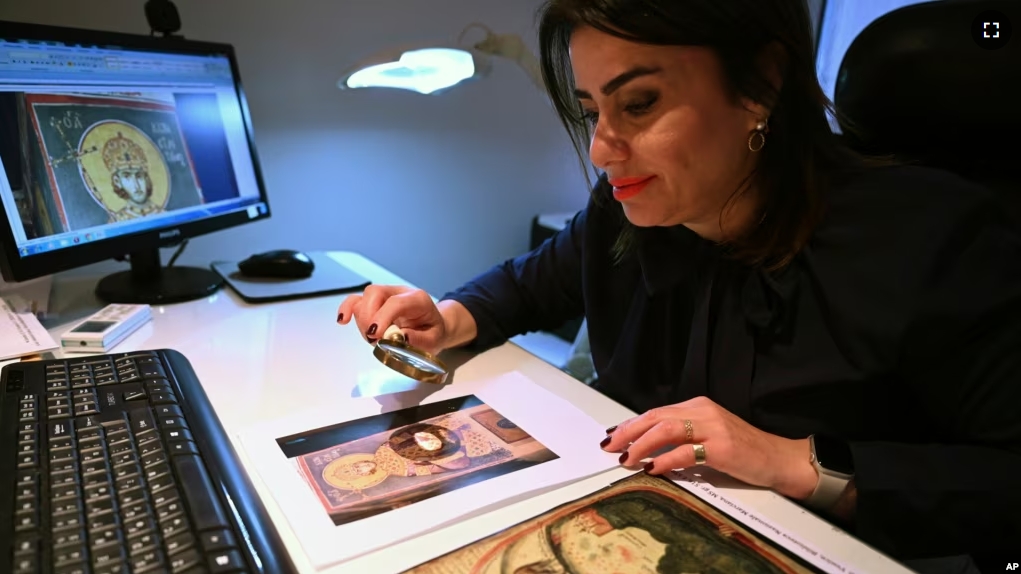Crime-solving methods might have provided an answer to an ancient mystery — the identity of a leading Byzantine painter.
The artist Giotto who lived in Italy about 700 years ago is often considered the father of Western painting. But at the same time that Giotto lived, Manuel Panselinos was equally important to a different tradition: the art of Byzantium.
The art of Byzantium can be found in Eastern Orthodox churches across Greece, Serbia and other Orthodox countries. Byzantium is an ancient name for the modern city of Istanbul.
Who was Panselinos?
Nothing is known of Panselinos’ life. Historians now believe Panselinos was a nickname. They now suspect his real name was likely Ioannis Astrapas. He was from the northern Greek city of Thessaloniki.
Work said to be made by Panselinos, from the late 1200s and early 1300s, is considered the finest produced in the Byzantine empire. That ancient empire covered parts of Europe and Asia. It lasted from the fall of the Roman Empire until the capture of the capital Constantinople by the Ottoman Turks in 1453.

Art historians had long suspected that “Panselinos” could have been a nickname, or a pseudonym, for a member of the Macedonian School of painting in Thessaloniki. The name means “full moon” in Greek.
Recent research by a Greek monk and a language expert have linked Panselinos with Macedonian School painter Astrapas.
Now handwriting expert Christina Sotirakoglou has found new evidence. She matched lettering on a document thought to be by Astrapas with writing on a church painting at Mount Athos in northern Greece. The Protaton church painting has been considered Panselinos’ best work.
Father Cosmas Simonopetritis is a former administrator at Mount Athos; the religious community is where the Protaton church stands. He said Sotirakoglou’s and his own research “clearly prove” Panselinos’ real identity.
“Panselinos was a real person, and (the name) was just the nickname by which Ioannis Astrapas became known,” Simonopetritis told the Associated Press (AP).
Constantinos Vafiadis is a professor of Byzantine art who was not involved in the research. Vafiadis said he found strong points in the nickname theory and naming Astrapas as the true artist. However, he added that it appeared more than one painter had created the art at the Protaton church.
“I agree with attributing part of the paintings to Ioannis Astrapas,” Vafiadis said. “But again there remains much ground for future research into that person, because other Mount Athos monuments from the same period have not yet been sufficiently published.”
“Panselinos” and his fellow artists at the time are linked with a rebirth in Eastern Orthodox art. Their work brought back forms and skills inherited from ancient times. Facial expressions got a deeper humanity, and greater attention was paid to proportion and depth of field in composition.
Simonopetritis said Astrapas was an “extremely gifted painter” with deep knowledge. He added that Astrapas mixed “the ancient, classical world with Orthodox Byzantine spirituality.”

How they did it
The trail started with linking Astrapas to the person who wrote a book called the Marcian Codex GR 516 from the early 1300s. The book contains artwork and is handwritten in Greek. Among the painted pictures, or illustrations, is a full moon.
“For me … that was the main proof,” Simonopetritis said.
With a name found for the person who produced the manuscript, the next step was to compare it to the writing on the painting in the Protaton church that has been traditionally linked with “Panselinos.”
“Mrs. Sotirakoglou, who is a handwriting expert, filled in that blank,” Simonopetritis said.
But women have for more than 1,000 years been banned from entering the Mount Athos religious community.
“I was forced to study the Protato paintings based on photographs,” Sotirakoglou told the AP. Sotirakoglou works as a court expert who examines handwriting in criminal cases.
The first clue came from the Greek letter “Phi,” the English “F,” in the Marcian codex manuscript.
“It’s a Phi that stands out, and is similar” in both the manuscript and the Protato painting, she said. “Matches also followed with other letters, T, with its proportions, which is bigger, covering the other letters and is topped with a curve, the proportions of the K.”
“But when the Phi was revealed, the code of the writing was broken and the job became much easier,” she added.
Father Cosmas said that during his duties on Mount Athos he attended services at the Protaton church every day.
“That’s where my desire was born…to explore the mystery around the name and the identity of Panselinos,” he said, adding that he thinks the artist has now gotten “his true identity.”
I’m John Russell.
Costas Kantouris and Nicholas Paphitis reported this story for the Associated Press. John Russell adapted it for VOA Learning English.
____________________________________________
Words in This Story
nickname – n. a usually descriptive or familiar name given instead of the one belonging to a person
monk –n. a male member of a religious group in certain religions who lives in a community apart from the rest of society and does not marry or hold much property
handwriting – n. writing done by hand
attribute – v. to consider or reckon as made in an indicated fashion
